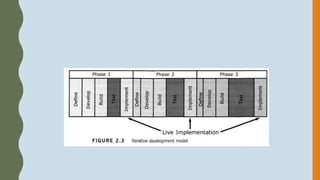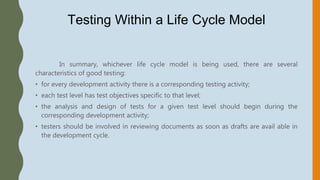Testing is not a stand-alone activity. It has its place within a software development life cycle model and therefore the life cycle applied will largely determine how testing is organized.
There are many different forms of testing. Because several disciplines, often with different interests, are involved in the development life cycle, it is important to clearly understand and define the various test levels and types. This chapter discusses the most commonly applied software development models, test levels and test types. Maintenance can be seen as a specific instance of a development process. The way maintenance influences the test process, levels and types and how testing can be organized is described in the last section of this chapter.









![AGILE DEVELOPMENT
Extreme Programming (XP) is currently one of the most well-known agile
development life cycle models. (See [Agile] for ideas behind this approach.) The
claims to be more human friendly than traditional development methods. Some
characteristics of XP are:
• It promotes the generation of business stories to define the functionality.
• It demands an on-site customer for continual feedback and to define and carry out
functional acceptance testing.
• It promotes pair programming and shared code ownership amongst the developers.
• It states that component test scripts shall be written before the code is written and that
those tests should be automated.
• It states that integration and testing of the code shall happen several times a day.
• It states that we always implement the simplest solution to meet today's problems.](https://image.slidesharecdn.com/1-171127061918-4ce762/85/Testing-Throughout-the-Software-Life-Cycle-Chapter-2-10-320.jpg)

